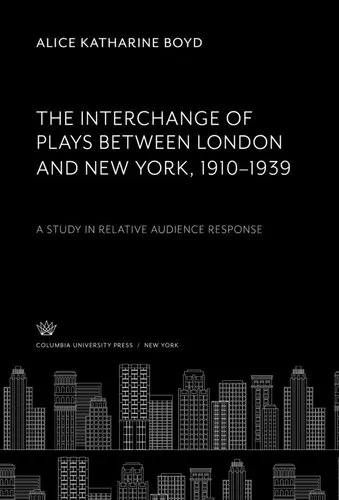The Interchange of Plays Between London and New York, 1910–1939: A Study in Relative Audience Response
4.9
Reviews from our users

You Can Ask your questions from this book's AI after Login
Each download or ask from book AI costs 2 points. To earn more free points, please visit the Points Guide Page and complete some valuable actions.Introduction to "The Interchange of Plays Between London and New York, 1910–1939: A Study in Relative Audience Response"
In the early twentieth century, two of the world's most culturally vibrant cities, London and New York, became thriving hubs for theatrical exchange. This book delves into the transatlantic interchange of plays between these vibrant metropolises during the three decades from 1910 to 1939, shedding light on how different audiences shaped, influenced, and responded to shared theatrical works.
Detailed Summary of the Book
The book begins by setting the historical context, exploring how sociopolitical and economic factors contributed to the rise of theatres in London and New York as major cultural centers. It outlines the differences between the theatrical productions of each city, noting the distinctive characteristics of plays that frequently crossed the Atlantic Ocean. Through meticulous research, this work examines the specific plays that gained traction in both cities, from iconic Shakespearean productions to contemporary dramas and musicals.
Through an analysis of popular productions, the book discusses the ways in which these two unique audience bases received and interpreted shared cultural experiences. A significant portion of the book is dedicated to studying how the local culture of each city influenced audience reception and critiques. The narrative offers a chronological journey through the period, connecting individual plays to broader cultural trends and events, such as the aftermath of World War I and the Great Depression.
Furthermore, the book delves into the mechanics of production, the role of playwrights, directors, actors, and other creatives in influencing how plays were adapted for each audience. This exploration reveals the intricate relationship between production techniques and audience expectations, providing insights into the theatrical ecosystem of the period.
Key Takeaways
- The dynamic exchange of plays between London and New York was instrumental in shaping the global theatre circuit.
- Factors such as political climate, technological advancements, and cultural trends significantly affected audience preferences and reception.
- Audience responses were influenced by local cultural norms, yet there were instances of remarkable synchronicity across the Atlantic, highlighting a shared cultural zeitgeist.
- The role of theatre as a form of commentary on social issues was critical in both cities, reflecting the complex interplay of art and society.
Famous Quotes from the Book
"Plays are not merely performances; they are cultural dialogues that transcend borders, reflecting the collective consciousness of their time."
"The transatlantic exchange of theatre between London and New York in the early twentieth century was both a mirror and a molder of public sentiment."
"In the shadow of world conflict and economic turmoil, the theatre became a sanctuary for shared human experience and cultural exchange."
Why This Book Matters
This book is essential reading for anyone interested in the history of theatre and its impact on cultural relationships between these two great cities. By analyzing the period from 1910 to 1939, it provides invaluable insights into how the arts can bridge divides and foster understanding across diverse communities. It underscores the power of performance to both reflect and challenge societal norms, and how understanding past audience responses can inform contemporary theatrical practices.
The exchange of plays was not just a mere cultural transaction but a profound interaction that informed and enriched the artistic and cultural narratives of both London and New York. By studying this interchange, readers gain a deeper appreciation of the mechanisms governing cultural transmission and the transformative power of theatre.
Free Direct Download
Get Free Access to Download this and other Thousands of Books (Join Now)
For read this book you need PDF Reader Software like Foxit Reader
Accessing books through legal platforms and public libraries not only supports the rights of authors and publishers but also contributes to the sustainability of reading culture. Before downloading, please take a moment to consider these options.
Find this book on other platforms:
WorldCat helps you find books in libraries worldwide.
See ratings, reviews, and discussions on Goodreads.
Find and buy rare or used books on AbeBooks.


